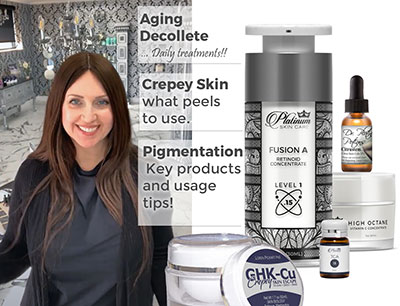
Transcript:
Today I want to talk treating the Décollete to help with crepeyness, aging and hyperpigmentation.
The décolleté is the area from the neck down to the upper chest (top of bosoms). This area can really show your age quickly. Speckles, spots and crepey skin can be very prominent, and this is really bothersome for many people.
This area gets targeted because:
• It has very thin skin.
• It has less follicles ….so it heals slowly and it is drier!
• It also Doesn't get as much protection as the face.
The skin on your neck and décolleté is actually thinner than the majority of your face (excluding your chin and upper forehead). So even though this is a body part – you can see why it get more irritated and we need to be gentler with it.
Treat this area as you would your Eye Zone! That is actually the only area on your body that is thinner.
Here is a great rule to follow.
Treat more conservatively and, more often
Thinner skin needs greater care - and products that are a bit milder.
Daily first. Whether you want to end up doing a peel or not, you always need to have a great regimen. I find that just using the same products that you are putting on your face… and pulling them all the way down is the Best, and certainly easiest way of taking care of your decollete.
Just in case you do not have a great regimen though… here are some KEY things you need to be using.
Vitamin C - to brighten and lighten the skin's tone. It will also help with collagen and elastin production - which is going to be at the top of your list if you sleep on your side as well. Apply Vitamin C every morning.
Copper Peptides – Here is one specifically for Crepey skin… but you can use the CP Serum or the GHK 7% in your favorite serums if you wish. Copper peptides are made for tissue regeneration. This is helpful not only for collagen deep in the skin, but for tightening the skin and replacing damaged tissues with new ones. Apply copper 1-2x per day to help. Add some emu oil on top for penetration and hydration.
Retinoids – Fusion A .15 – I cannot stress enough how important retinoids are for your skin’s health. They will help to begin the discoloration removal process in the skin while smoothing and stimulating collagen production. It will also help to get your skin in a hyper regenerative mode. This will help when you perform a peel so the skin will heal more quickly.
I want to mention one more product that I just find so helpful for every day use on the décolleté. It is also amazing for healing after peels – which I am going to talk about next.
Epidermal Growth Factors – Regenerate – When EGF is applied to the skin it stimulates your skin’s natural wound healing response. It can stimulate natural moisture production, elasticity, cell growth and cell division. Basically, it can help to regenerate new fresh skin tissues. This is very anti-aging.
Here are some Peel Options for you.
A couple of great acids for this drier, more sensitive area would be either a Mandelic 40% or a lactic 50%. Mild peels like this could be done 1-2x per month on the décolleté. Both are excellent for hyperpigmentation, and neither will cause anything more than some light dryness and maybe a few flakes.
That doesn't mean that you can't do a great peel on your décolleté, but you'll want to start with something milder such as 2-3 layers of our TCA 7% and work your way up from there to a 13% and so forth.
Even after several months, you would not want to ever apply anything higher than a 20% TCA maximum. Some doctors will go a bit higher, but we aim for safety at home. This could be done one time per month maximum.
Remember, the downtime is not what really matters here!
Cumulative, mild treatments are what is beneficial on thin skin.
When performing a peel on the body, expect a longer healing time than on the face. With less pores, the healing is slowed, and flaking is more minimal. This is why we recommend only 1 or 2 peels per month. Your body needs a longer time to complete the process.
Most people feel very dry and "sand papery" about a week or so after a peel, but don't see "flakes" like on the face - though everyone is different, and you may see some.
Anything that helps to stimulate collagen like Syn-TC, or elastin production like Citrustem would be a perfect addition to any décolleté treatment plan. And if you have pigmentation - which is most likely a yes - than a topical daily melanin inhibitor such as Fade Bright with alpha arbutin and resveratrol would be extremely helpful.
Remember, if you can put it on your face, you can put it on your neck and chest as well. Aging isn't just limited to the face. Sometimes we spend so much time on our faces …. that our necks, chests and hands are the ones that give away our age!



